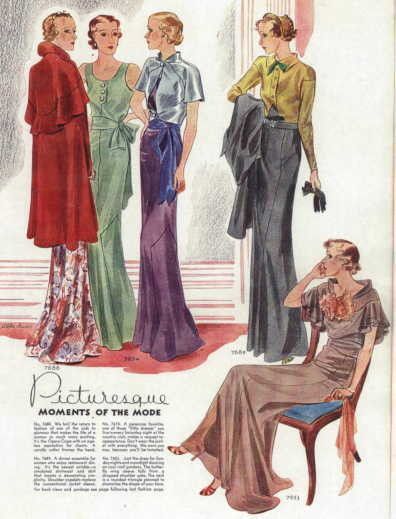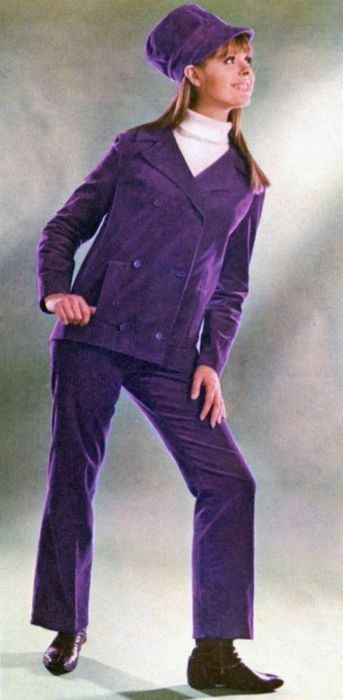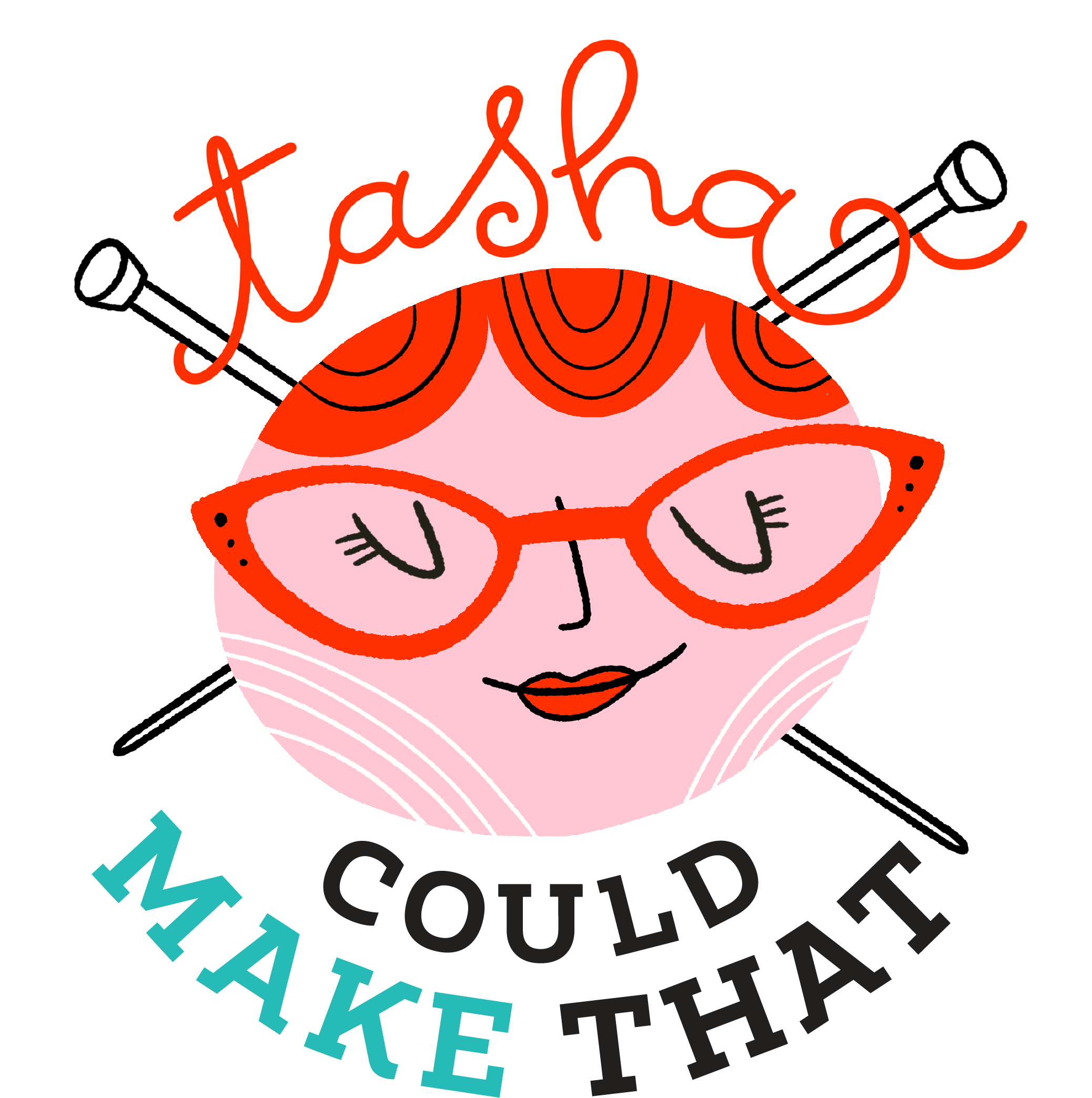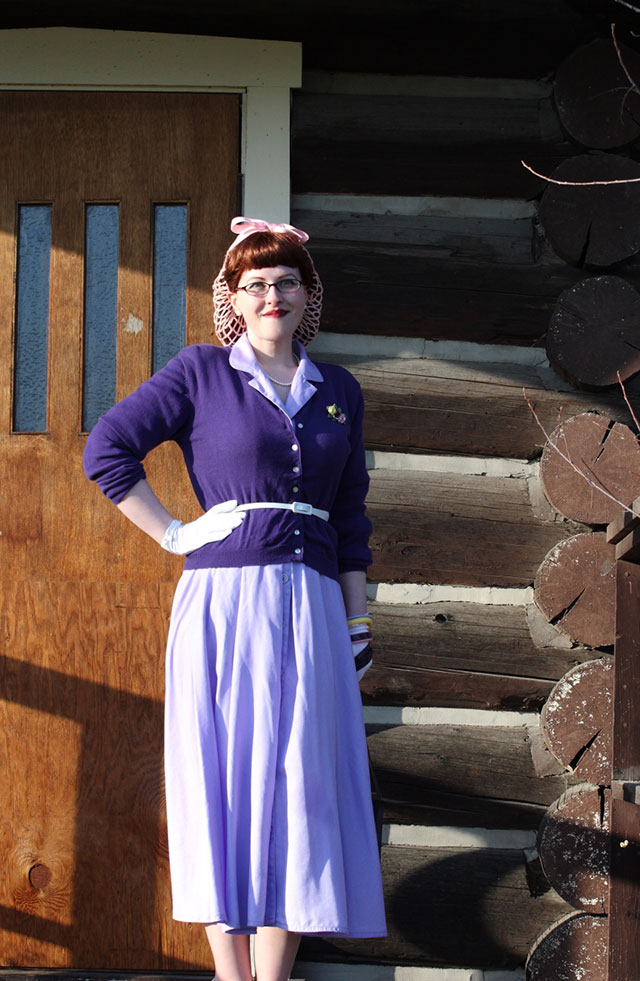Happy Friday! I’ve got a great guest post for you today.
If you follow the lovely Jessica of Chronically Vintage, you know she is a passionate writer and vintage aficionado. Lately, I’ve been occasionally finding myself drawn to a color outside of my comfort zone: purple. I’ve had a little bit of an obsession with it lately, I have to admit! A quiet one, though. A little bit of purple fabric and yarn has snuck into my stash, a bottle of periwinkle nail polish, and a pair of grape shoes may have also found their way into my wardrobe this summer.
I hatched a little idea. When I approached Jessica about doing a guest post about purple, I knew the request might seem odd to some, but it would be right up her alley. And as expected, she took the topic and ran with it!
So sit back, grab a cup of tea and enjoy Jessica‘s fascinating look into the history of the color purple!
Very few colours have shared the same degree of prestige that purple has held throughout much of human history. Notoriously hard to source in the ancient world (shells from a sea snail called the spiny dye-murex were one of the main sources that cultures such as the Greeks and Romans used), the scarcity and rarity of this beautiful hue all but ensured that it was the almost exclusive domain of the very well off. As such it had longstanding ties to both many a royal family, nobleman, and the religious elite of Europe, and continues to be seen as a colour of power to this day.
Not only was purple a rare colour to spot in one’s wardrobe for many a century, it is a relatively uncommon colour to encounter in nature as well. Certain flowers, a small number of edible plants, fruit and vegetables, and an especially tiny array of animals (such as the purple martin) are tinted purple, but by and large, it’s not a colour one would have traditionally stepped outside and encountered much, if any of, in their own backyard. This rarity factor only helped bolster purple’s popularity amongst the well-to-do, while lending it a certain air of mystery, prestige, and even spirituality.
Fortunately however, for those who enjoy purple, innovations in the field of coloured synthetic dyes over the two centuries (one of which came about in 1856 when a young chemist named William Henry Perkin was hard at work trying to create a synthetic form of quinine) in particular have helped to knock purple down from its royal throne and into the hands of all who enjoy this elegant colour.

{Though purple had been used by many in in the upper echelons of society for millennia, it wasn’t until advances in synthetic dyes in the mid-nineteenth century that various shades of this colour began to find their way into the wardrobes of of those outside of the ultra wealthy. As it became easier to produce and thus obtain on the retail end of things, purple’s popularity quickly spread and was widely adopted by many Victorians, as this lovely Godey’s Ladies Book fashion plate from 1861 shows.}
As the Victorian era plowed onward, purple quickly became a favourite colour of both the fashion set and many leading artists (from Renoir to, at the turn of the century, Klimt). It was one of one the colours permitted during the second half of a traditional mourning period (mauve, lilac, lavender and dark purple were typically all permitted), and also found favour amongst those who weren’t in grieving. As time marched forward and the Victorian age gave way to the Edwardian age, purple came to be highly associated with one of the most important social causes of the era: women’s suffrage. (Green, gold, and white were also colours tied to this incredibly important cause on both sides of the Atlantic.)
Many Edwardian fashions were rife with colour, and purple was a popular player amongst fashion designers and the ever-expanding mass-produced garment industry alike. Shades of amethyst, lavender, plum, hydrangea, aubergine, thistle, orchid, and grape, to name but a few, appeared fairly often through the jewelry, fashions, hats, and even shoes of the era, whether in small doses (say a violet-hued plume sticking jauntily out of a hat) or long evening dressing flowing over tightly corseted waists, and very nearly everything in between.
Of all the decades of the twentieth century, it is the first two that I associate most closely with purple, especially when it comes to jewelry. This elegant colour was a much loved fixture in costume and fine jewelry of the time alike, with its use springing up on everything from cameo brooches to embellished hair combs, jewel or glass stone adorned earrings to stunning amethyst necklaces.

{A rare early colour photograph, c. 1915, of a stately elderly woman wearing two shades of purple from head to toe while sitting in a library.}
Especially in the pre-WWI years, this was an age of both luxury and dramatic change, social upheaval and life altering progress, and purple seemed to suit the bold, powerful, revitalizing movement of the time particularly well.
All of these elements continued on into the 1920s, as the world struggled to rebuild and reshape itself in the aftermath of a game changing war. Out were some of the old constrictions–be they placed by society or fashion–on a woman’s body and rights, in came (for some) an unprecedented amount of freedom and plenty of new possibilities.
Women in many countries had already (or were finally starting to get) the right to vote; hemlines rose, ladies hit the workforce in greater numbers, motion pictures showed starlets in all manner of glamorous garb right in front of one’s eyes for no more than the few cents a ticket cost, cars were far outnumbering horses on the streets, and the flapper that we’ve all rightfully come to associate with the decade, spread her charm and distinct sense of style from coast to coast.
Though I would argue that purple was not quite as widely used (on the fashion front) during the 1920s as it was in the proceeding few decades, it was still a popular colour nevertheless and one that jived splendidly with the renewed wealth and success that America was experiencing as it climbed out of the dark years of WWI. Myriad shades of purple pop up time and time again in art deco jewelry, cloche hats, Asian inspired dressing gowns, and various other fashions, from dresses (not uncommonly those in silk and velvet) to to feathered headbands.

{Colour was alive and well in the fashions of the 1920s, and purple was certainly no exception. In this lovely fashion illustration of the decade, it shines beautifully in a two-piece lilac checkered skirt suit with matching purple cloche hat.}
Just as the 1920s has seen great wealth and prosperity, the 1930s – with the Great Crash of 1929 – quickly watched the the world change almost as quickly as the stock market had collapsed. For many, the idea of free living, fun loving good times spent in knee-grazing flapper frocks suddenly seemed almost inconceivable in the stern face of the Great Depression, and the great many sacrifices that countless people were making the world over everyday just to barely survive.
Purple, always a colour associated with wealth, glamour and luxury, took a bit of a backseat to many other hues (such as black, brown, blue, red, navy, and green) during the decade, quite understandably, but it was not brushed to the wayside entirely by any means. It continued to enjoy the spotlight in both art deco style jewelry and various garments, including suits, hats, dresses, (velvet) capes, and handbags.

{Lithe, elegant women model glamorous evening looks in this 1930s fashion illustration, which includes one dusty grape hued purple gown – a sight that would be something of a rarity through much of the decade.}
As the thirties wore on and things began to slowly take an upturn for many towards the end of the decade, purple popped up in other wardrobe spots as well, including in many of the delightful novelty print dresses and blouses that were fast gaining popularity. It would remain in place on such garments as the world plummeted into the next decade, embroiled in widespread war for the second time in little more than twenty years.
Times were tough, rations ruled, and a make do and mend mindset helped ensure that far fewer fashions were produced during the early day of the 1940s than had been prior to the war. Interestingly however, especially in America, those that were still produced often featured vibrant, beautiful colours and patterns, which many designers and consumers alike saw as important for helping to keep up morale and spirits on the home front. As such, purple remained relatively common throughout WWII, appearing on everything from skirt suits to ruched rayon dresses, high heels to handmade knitwear.

{Purple plays a supporting role, via the model’s gloves, in the beautiful colour palette that makes up this bracing sophisticated 1940s ensemble, though in many outfits through the era, it also factored in as the principle colour.}
As the tides of war broke at long last in 1945 and fashion gradually began to recoup from the effects of several years of heavy war rationing, colour continued to thrive across the board, and purple held its ground quite well, hopping seamlessly from the forties on into the prosperous decade that was the fabulous fifties.
There was scarcely a colour alive that didn’t see some action during the 50s, as fashions–though still often wildly glamorous–took on a decidedly more casual, sportswear driven trend (which has yet to let up to this day) during the decade.
Purple–all manner of shades, but especially some of the more feminine and youthful hues–appeared in everything from crinolines (pettiskirts) to cardigans, floral print pumps to circle skirts, shirtwaist dresses to swimsuits. Nary a garment was without at least a few purple versions during this vibrant decade. A decade that once again spelled prosperity, hope, and good times for many.

{Dark shades of lavender glide gracefully over a model’s curves as she sports a textured sleeve-less sheath dress with matching purple gloves partnered with the decade’s endlessly iconic classic pearl jewelry. This look says so much about the state of glamour and the role of purple through the 1950s, an decade teeming with feminine styles, vivid colours, and a penchant for matching one’s accessories to their outfit.}
Though purple has never been seen as quite as quintessentially feminine as pink, it is no doubt often associated with women and femininity, two key factors in much of the fashion that prevailed in the 1950s, which likely explains in part why purple was a much loved hue–from both the perspective of fashion designers and their public alike during the era. Purple also really began to be associated with youth around this time, and as teenage culture reached new heights and carved out a fashion market all its own during the fifties, purple gain further widespread appeal and popularity.
If purple jewelry and the Edwardian era go hand-in-hand, then fashion and all things violet-inspired made for bosom buddies during the 1960s. Clothing in the earliest years of the decades continued to being relatively similar to its late 1950s relatives, which meant plenty of feminine cuts, patterns, accessories, and colours. Purple was wholeheartedly included.
As the sixties progressed and the sometimes twee, often sophisticated, and typically elegant fashions of the early decade gave way to the innovative, streamlined, artistic looks of the Mod fashion movement, as well as the earthy, world traveller-inspired styles adopted by bohemians and counterculture members near and far. Throughout it all, however, purple held its ground. Once again it took on a politic bent, becoming closely associated with the Women’s Liberation Movement of the 1960s and 70s, just as it had once held an important place with the suffragists at the turn of the century.
Purple was many things to many folks throughout the sixties. In a crushed velvet skirt or vest, it could be fun and free, youthful and dramatic. On a Mod model, it might have been colour blocked, used heavily in eye makeup, even laced up as a pair of go-go boots. For those who retained a more classical sense of style, it was at the ready in everything from tweed skirt suits to pillbox hats, pointy-toed heels to hip-grazing wool capes.

{Much as in the 1950s example above, purple dominates this outfit, yet the two are markedly different. Here swingy pants and a carefree hat have replaced the prim and proper lines of the fifties sheath dress, representing in doing so everything from the predominate role of youth culture during the era to the changing social views that feminism was ushering in with each passing day. This look is groovy and fun, it thumbs its nose at conformity and in doing so unintentionally channeled purple’s long history of standing apart from the sartorial norm of the day.}
Purple appeared frequently in patterns near and far during the swinging sixties, in polka dots, Liberty florals, paisleys, stripes, and even houndstooth. It popped like a sunrise against reds, yellows and oranges, then mellowed when married to cooler hues such as green, aqua, blue, indigo, and cream. Sometimes it stood alone, in vast quantities, comprising whole outfits. Assertive, beautiful, and perfect for an age that once again saw far more chances than any one colour could ever imagine when the decade began.
In the years that would follow in the second half of the twentieth century, purple continued to remain popular, waltzing in and out of vogue, never falling off the radar, nor losing its ingrained sense of versatility.
It was earthy one day and glitzy the next, bogging its way into disco studios everywhere during the seventies. In the power-driven 1980s, purple, not surprisingly, was widely embraced once more both by women, and to a lesser extent even men, who sported it on everything from oversized blazers to workout wear, bikinis to plastic sunglass frames. It shone as one of the decade’s pastels, but also cropped up in a number of darker shades, not infrequently in the form of lace, sequins or leather.
As the final chapter of the last century dawned, purple took to vivid new heights as a youthful neon, bursting forth from the garden of grunge scene floral dresses, colour blocked once more, and could be found in nearly every clothing store from one end of the earth to the other.
Once a colour that had been reserved for only the most elite of society less than two hundred years prior, purple had truly come full circle. By the end of the nineties, few, if any one us, were without at least one lilac, lavender, plum, violet, or eggplant garment, bottle of nail polish, or accessory in our wardrobe. Proving once more, just what kind of appealing power this gorgeous colour holds.
Wow! Thanks, Jessica, for such delightful insights into the color purple! And for you readers who might now have this color on the mind, Jessica shared her own wonderful violet-hued outfit.
I think this look just epitomizes purple perfection. Jessica’s vintage style is delicate and feminine, with wonderful combinations of color. If you haven’t stopped by her blog Chronically Vintage, what are you waiting for?
Thanks again for sharing this wonderful history with us, Jessica! ♥


What a fun post! I have been super into the color purple lately too, My favorites are the deep rich eggplant shades, perfect for fall! I just recently posted about two purple dresses which are now in my shop.
here: http://frocksandfrivolities.blogspot.com/2013/10/oleg-cassini.html
and here: http://frocksandfrivolities.blogspot.com/2013/09/new-to-shop-purple-floral-dress.html
These two dresses are such pretty purples, it is hard to let them go, but they deserve to be worn and they are just not styles that fit my life of chasing around kiddos!
Such an interesting post! With color so readily available to us now, it’s neat to imagine how special seeing certain colors were in the past. We don’t appreciate the wealth we have!
It was such a fabulously fun joy to write about the history of colour purple, dear Tasha. Thank you very much for giving me the opportunity to do so, and to be a part of your gorgeous blog (which you know I’m endlessly crazy about!) this month.
Here’s to the blossoming expansion of the violet hued section in both our wardrobes and to always enjoying sporting colour on the vintage attire front!!!
♥ Jessica
What a wonderful subject! So central to fashion and yet so revealing about society. I’ve always been entranced by the color purple. And I’ve always admired Jessica’s writing ability. Nice post!
Thanks, very interesting stuff. I love purple, and have been thinking about adding it to my wardrobe lately.
Great post! Purple has always been my favorite color. Thanks for asking Jessica to write this! When will we see you in your purple?
Ha ha, good question! Well there will definitely be a deep violet sweater in the hopefully-not-too-distant future on my knitting needles at the very least. 😀
I have always enjoyed thinking about the Roman Emperors in their ‘royal purple’ 🙂 Not that it is the same purple we have come to love today, but still… 🙂
Nice to ‘see’ you here Jessica!
Thanks Tasha for suggesting this idea 😉
Jessica, you are a wealth of information!!! What a wonderful and educational post!
xoxo
-Janey
Fantastic to learn more about this elegant colour – I am very interested in fashion history so it’s fair to say I devoured this post! Thank you to Jessica for all the work (including wonderful illustrations) she put into it. I love purple, too and it’s one of those colours which I truly believe suits all colouring. My first pair of adult shoes was a (very pointed!) kitten heel deep purple pair, so my affection goes back a long way!
Love this post and love purple as well!!!!
Jessica, you never cease to amaze me with your knowledge of fashion history. I can’t say purple is my favorite, but I do love to incorporate it in my wardrobe. However I have very little of it in my wardrobe.
The Fictionista
{sean-mackenzie.blogspot.com}
I love purple, it is such a beautiful colour. This was a really interesting read.